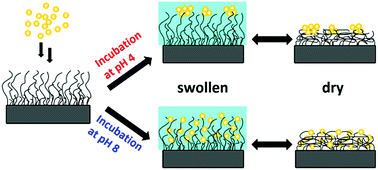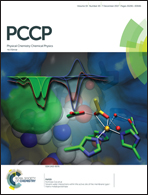The internal structure of PMETAC brush/gold nanoparticle composites: a neutron and X-ray reflectivity study†
Abstract
This work addresses the pH-triggered distribution and relocation of charge-stabilized gold nanoparticles (AuNPs) incorporated into strong polyelectrolyte brushes. Brush/particle composite materials were investigated under aqueous conditions and at different humidities using neutron and X-ray reflectivity, respectively. X-ray reflectivity measurements complement neutron reflectivity measurements and reveal results that could not be observed by neutron reflectivity measurements. Both methods allow scanning the particle density profile, but due to different contrasts, they are sensitive to different regions within the brush. More specifically, 3-mercaptopropionic acid (MPA)-coated AuNPs were incorporated into poly-[2-(methacryloyloxy)ethyl]trimethylammonium chloride (PMETAC) polyelectrolyte brushes at different pH values. The pH value triggers a change in the AuNP surface charge caused by the pH-sensitivity of the MPA ligands, while the charge of the PMETAC brush is not affected by pH variations. The particle number density as well as the particle distribution depend strongly on the pH value of the incubation medium: a rather non-homogeneous assembly (2D assembly) is found when the PMETAC brush is incubated in AuNP suspension at pH 4, while a more homogeneous assembly (3D assembly) is found when the PMETAC brush is incubated in AuNP suspension at pH 8. The main factor dominating the formation of 2D or 3D assembly is assigned to the particle–particle interaction and not to the particle–polymer interaction. No significant relocation of AuNPs within the brush can be found by changing the environmental conditions. The control of particle amount and distribution within the polymer brush has a strong impact on the optical properties of those composite materials, which is crucial for the fabrication of colorimetric sensors.



 Please wait while we load your content...
Please wait while we load your content...